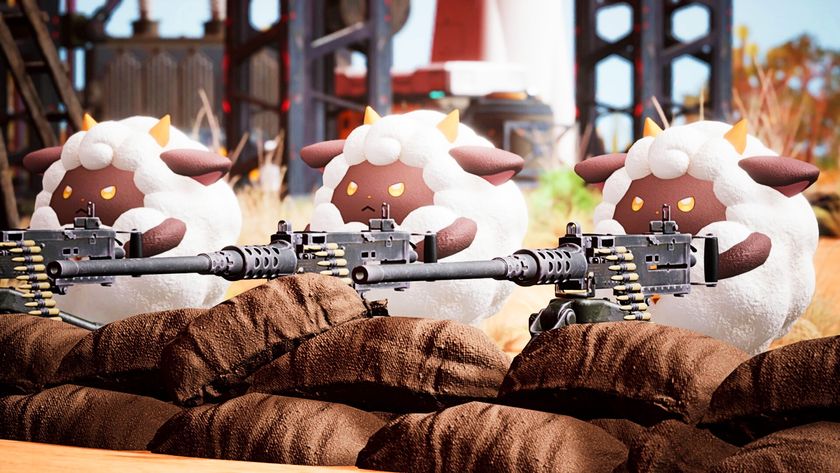The guns of World War II
VIDEO FEATURE: How do the shooters in Medal of Honor: Airborne stack up against the real thing?
The gun: Springfield M1903 sniper rifle
The history: Pressed into US military service in 1903, the bolt-action Springfield was for decades the standard armament of US troops, and it remained in wide use even after the M1 Garand officially replaced it in 1936. Its bolt-action design made for a slower rate of fire than the Garand, which in turn made it impractical for fighting against the lightning-fast German military, although the rifle's accuracy kept it in use as a sniper rifle even during the Vietnam war.
How it feels: Bigger, heavier and dumber than the Garand, even if its sniper scope gave it a sweet edge in accuracy. Since it's an older, clumsier design, the Springfield also kicks a little harder than the Garand, and fiddling with its bolt-action cocking mechanism is a skill that takes practice. Given that American soldiers were saddled with this beast until 1943, it's obvious why the Garand's semiautomatic firing speed and slightly less clunky design would be seen as a huge improvement.
Reality vs game: Since it's relegated to a sniping role in the game, it's easier to forgive the Springfield's bolt-action design while playing Airborne; you're not necessarily looking to fire off a quick volley of shots while you're perched high on a roof, after all. You won't get a real sense of its clunkiness or power, either. Oh, and in real life, your garden-variety sniper scope doesn't give you tunnel vision, or have instantly adjustable zoom features. Just so you know.
How well is it replicated? Surprisingly well, actually. Much like the real thing, it's hard to keep the heavy Springfield steady when you're aiming down its scope at distant Nazis in Airborne, and firing it jolts the gun upward and shakes it around a little before you can aim again.
* * *
The gun: Thompson submachine gun
Sign up to the GamesRadar+ Newsletter
Weekly digests, tales from the communities you love, and more
The history: Also known as the Tommy Gun, the Thompson was designed in 1919 and marketed to civilians and police departments, but quickly became and still remains a symbol of Prohibition-era gangsters. That didn't stop the US military from adopting it in 1938, and during World War II, it saw widespread use as the weapon of choice for officers.
How it feels: After being beaten up by the Garand and the Springfield, the Thompson was a pleasant change of pace. Lighter and easier to aim than the rifles, the Thompson is meant to be tucked under your arm and shot from the hip, which means almost no recoil. The downside is that the it's almost guaranteed not to hit whatever you point it at, even when fired in short bursts; instead, you'll just get a wild spray of bullets flying in random directions. Only a few of the shots we fired even made it as far as the big sand hill at the far end of the range; the rest just plowed into the ground a few yards in front of us. But accuracy be damned! This thing was fun to shoot.
Reality vs game: What the hell is this? We were actually able to hit things with the in-game Thompson, and when we zoomed in to aim precisely, the enemy soldiers in front of us would even die occasionally. Preposterous!
How well is it replicated? Aside from the troubling concessions to fun gameplay over frustrating reality, the in-game Thompson is as close a facsimile to the real thing as you can get - right down to the tight-fisted thrill you get from spraying a wild blast of shuddering death out the end of it.
The history: Pressed into US military service in 1903, the bolt-action Springfield was for decades the standard armament of US troops, and it remained in wide use even after the M1 Garand officially replaced it in 1936. Its bolt-action design made for a slower rate of fire than the Garand, which in turn made it impractical for fighting against the lightning-fast German military, although the rifle's accuracy kept it in use as a sniper rifle even during the Vietnam war.
How it feels: Bigger, heavier and dumber than the Garand, even if its sniper scope gave it a sweet edge in accuracy. Since it's an older, clumsier design, the Springfield also kicks a little harder than the Garand, and fiddling with its bolt-action cocking mechanism is a skill that takes practice. Given that American soldiers were saddled with this beast until 1943, it's obvious why the Garand's semiautomatic firing speed and slightly less clunky design would be seen as a huge improvement.
Reality vs game: Since it's relegated to a sniping role in the game, it's easier to forgive the Springfield's bolt-action design while playing Airborne; you're not necessarily looking to fire off a quick volley of shots while you're perched high on a roof, after all. You won't get a real sense of its clunkiness or power, either. Oh, and in real life, your garden-variety sniper scope doesn't give you tunnel vision, or have instantly adjustable zoom features. Just so you know.
How well is it replicated? Surprisingly well, actually. Much like the real thing, it's hard to keep the heavy Springfield steady when you're aiming down its scope at distant Nazis in Airborne, and firing it jolts the gun upward and shakes it around a little before you can aim again.
* * *
The gun: Thompson submachine gun
The history: Also known as the Tommy Gun, the Thompson was designed in 1919 and marketed to civilians and police departments, but quickly became and still remains a symbol of Prohibition-era gangsters. That didn't stop the US military from adopting it in 1938, and during World War II, it saw widespread use as the weapon of choice for officers.
How it feels: After being beaten up by the Garand and the Springfield, the Thompson was a pleasant change of pace. Lighter and easier to aim than the rifles, the Thompson is meant to be tucked under your arm and shot from the hip, which means almost no recoil. The downside is that the it's almost guaranteed not to hit whatever you point it at, even when fired in short bursts; instead, you'll just get a wild spray of bullets flying in random directions. Only a few of the shots we fired even made it as far as the big sand hill at the far end of the range; the rest just plowed into the ground a few yards in front of us. But accuracy be damned! This thing was fun to shoot.
Reality vs game: What the hell is this? We were actually able to hit things with the in-game Thompson, and when we zoomed in to aim precisely, the enemy soldiers in front of us would even die occasionally. Preposterous!
How well is it replicated? Aside from the troubling concessions to fun gameplay over frustrating reality, the in-game Thompson is as close a facsimile to the real thing as you can get - right down to the tight-fisted thrill you get from spraying a wild blast of shuddering death out the end of it.











